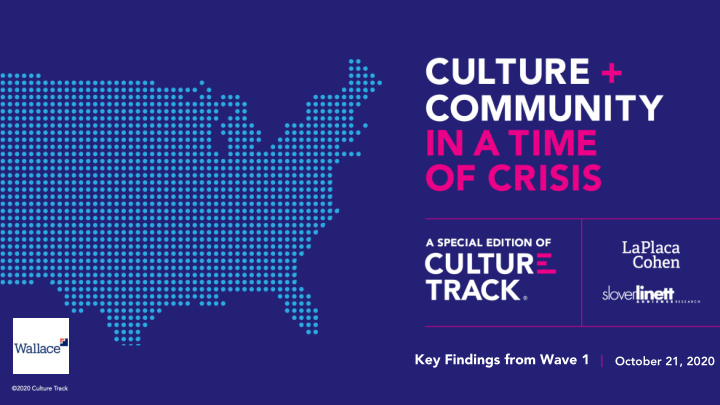



Key Findings from Wave 1 October 21, 2020
Key Sponsors and Partners 2
Survey Process • Participating organizations sent e- blast invitations to their respective lists • Wave One fielded late-April through mid-May 2020 • Wave Two to occur post-election/ Q4 2020; report in Q1/21 3
The cultural sector has an inclusion problem. 4
A National Portrait 5
COVID-19’s Current Impact on Audiences 6
The Emotional Toll Respondents report rising feelings of worry, boredom, and disconnection. 7
What Audiences Most Want From Culture 8
A Meaningful Role to Play Response patterns reveal four core community needs. 9
The Role of Digital in Audience Engagement 10
Missin Looking to Content Creators Respondents access digital cultural content from a variety of sources, with individual performers being the single largest category. Few are paying for online access to culture. 11
Live performances and on-demand content have the greatest awareness and use, while interactive offerings are not as widely adopted. Q: Which of the following online cultural activities have you personally seen being offered? (select all) Q: Have you done any of those online or digital cultural activities yourself in the past 30 days (select all) 40% % who were aware of this activity 37% % who participated in this activity 35% 34% 32% 30% 28% 24% 20% 17% 17% 17% 13% 12% 12% 10% 10% 7% 5% 4% Live-stream Pre-recorded Online Live interactive Online Online Virtual tours Podcasts Online Apps performances performance materials for events community classes exhibitions 12 s kids meetings
Digital activities are providing critical emotional support and escape during COVID-19. Q: What (if anything) did you get out of doing those online activities? (select up to 5) place or time • 54% Had fun • 33% Experienced artworks, performances, or performers • 21% Broadened my perspective or • 52% Relaxed or felt less stressed worldview • 27% Felt creative or creatively • 47% Learned or experienced inspired • 4% Celebrated my cultural heritage something new • 27% Spent quality time with my • 38% Escaped the stress of the real friends or family world • 22% Felt transported to another 13
Missin A Virtual Gateway Many respondents who are using online cultural offerings had not physically visited the same kinds of cultural organizations in the past year.
These digital content users who are non-recent visitors were frequently more demographically diverse than those who had been in person. Of the people using digital content from theatres , those who had not been to a theatre in • person in the past year were twice as likely to be Black or African American and twice as likely to have incomes <$25,000 than those who had been in person. Of the people using digital content from orchestras , those who had not been to a classical • music concert in person in the past year were 15x more likely to be Black or African American and three times more likely to be Gen Z than those who had been in person. Of the people using digital content from art museums , those who had not been to an art • museum in person in the past year were almost twice as likely to have a high school education or less (14% vs 29%) than those who had been in person. 15
Planning for Future Attendance 16
Missin Play to Emotional Strengths Respondents seek a variety of qualities from different cultural experiences, but activities that are fun, lighthearted, and beautiful appeal most.
Missin Protocols for the New Normal Organizations control 6 out of 10 factors that will influence respondents’ decisions to return to cultural activities.
Missin The Change Respondents Want to See Respondents indicate a variety of ways cultural organizations could change to be better in the future. 72% selected one or more of these changes. 19
In Their Own Words 20
21
22
23
Discussion 24
Recommend
More recommend